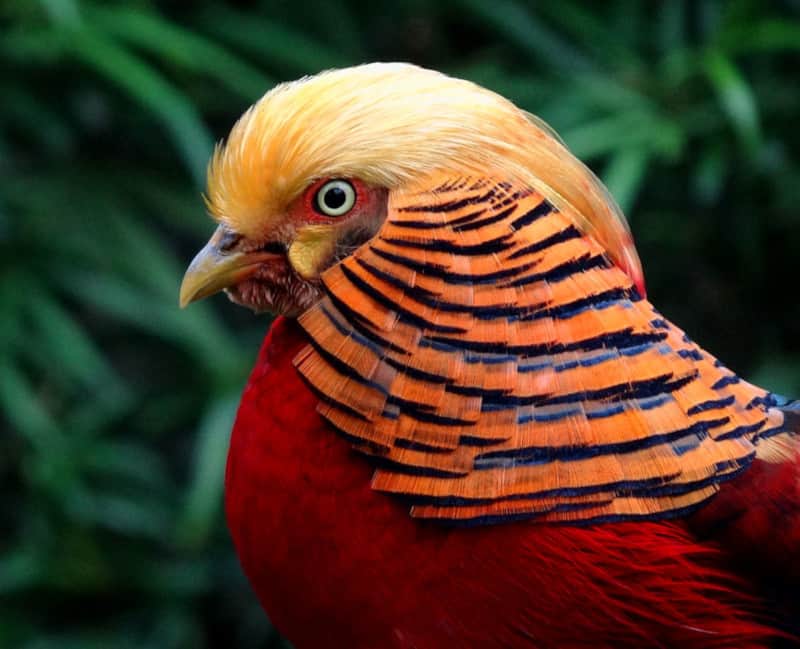Golden Pheasant Facts
- The attention-grabbing term of Golden Pheasant represents the most frequently used common name for this gorgeous bird. It does have other general titles, though. These include such terms as the rainbow pheasant and the chinese pheasant.
- Within the scientific community, however, it’s typically better known by its formal title. But, as often holds true in such situations, that’s a difficult term for the layperson to pronounce. That’s because it holds the technical moniker of Chrysolophus pictus.
- The animal received that name due to the efforts of the esteemed Swedish zoologist, Carl Linnaeus. He accomplished the first official recognition of the bird as a separate and distinct species. That scientifically noteworthy event occurred in 1758.
- Fortunately, the stunning Golden Pheasant appears to be maintaining a population base that’s both stable and sufficient. That pleasant situation also seems to hold true throughout the entirety of its native range. The IUCN thus lists it as Least Concern.
- The beautiful creature nevertheless faces some potential threats to its continued existence as a species, at least. Most of these stem from the actions of man. They include such possible dangers as habitat loss, and, of course, ongoing climate change.
Related Articles
Golden Pheasant Physical Description
The magnificent Golden Pheasant quickly piques the interest of most individuals who encounter one. Unlike some species, though, it does so for more than one reason. That’s true since it’s not only a remarkable beauty, but also boasts a respectable size.
It further follows a pattern common to many animal in this regard. That’s because, like many other species, it displays a certain degree of the physiological characteristic of sexual dimorphism. In its specific case, that trait manifests itself in both size and appearance.
Males generally attain a significantly greater size than their female counterparts. These reach a total maximum known length equaling approximately 41 in (105 cm). Of this length, though, the visually distinctive tail accounts for about two-thirds of the total!
Females, meanwhile, usually only grow to between 24 – 31 in (60 – 80 cm) in length. Like the males, the tail also equals a large portion of this. Yet, in her case, the percentage is quite different. For the female, the tail remains proportionately shorter, at half the overall length.
Masses naturally differ, given the size variation. Males generally weigh around 1.1 – 1.5 lb (500 – 700 g). The females of the animal typically measure about 0.77 lb (350 g). Exceptional individual specimens of both genders, in both respects, do occur, however.
The coloring of the two genders of the Golden Pheasant additionally vary significantly. Makes present a characteristic golden crest and rump. The bulk of the body shows a deep red hue. A deep orange cape also appears, that often covers the much of the face.
In sharp contrast, the plumage of the female presents as vastly different. These typically present as a primarily mottled brown in color. Examples of both sexes of this amazing species possess yellow bills and legs. Seen together, the pair make for a remarkable sight.
- Kingdom: Animalia
- Phylum: Chordata
- Class: Aves
- Order: Galliformes
- Family: Phasianidae
- Genus: Chrysolophus
- Species: C. pictus
Golden Pheasant Distribution, Habitat, and Ecology
The mesmerizing Golden Pheasant evolved as native to only a moderate section of the globe. There, however, it blended in well with the abundance of other biological wonders present. That’s due to the fact it developed as endemic to a portion of the continent of Asia.
More precisely, this marvel of evolution lives natively within the borders of China. Yet, even there it only naturally appears in the western regions. Now, though, wild populations, through the actions of man, live in many countries, including the United States and France.
Regardless of where it lives, the bird displays the same decidedly strong preferences in its choice of habitat. That evolutionary trait holds true for the above-mentioned locations, as well as all other regions where it’s now been artificially established.
It’s most highly preferred type of habitat seems to be relatively dense regions of coniferous forests. Some do, however, make their homes in areas of mixed forests with a thick concentration of shrubs. It also demonstrates a clear preference for mountainous areas.
The Golden Pheasant evolved as omnivorous in nature. It feeds during the day, choosing to roost at night in the trees. It consumes a variety of leaves and grains, as well as smaller invertebrates. The avian also prefers to find its food on the ground, rather than in the trees.
Breeding season usually occurs in the month of April After mating, females of the species typically lay between 8 – 12 eggs at a time. An average incubation period for these lasts between 22 – 23 days. In the wild, an average lifespan measures about 5 – 6 years.
Species Sharing Its Range
Check out our other articles on 5 Practically Perfect Penguins, Onyx River, Golden Armadillo Lizard, Gympie-Gympie, Wheel Bug, American Cranberrybush, Iberian Lynx, Jewelled Gecko

